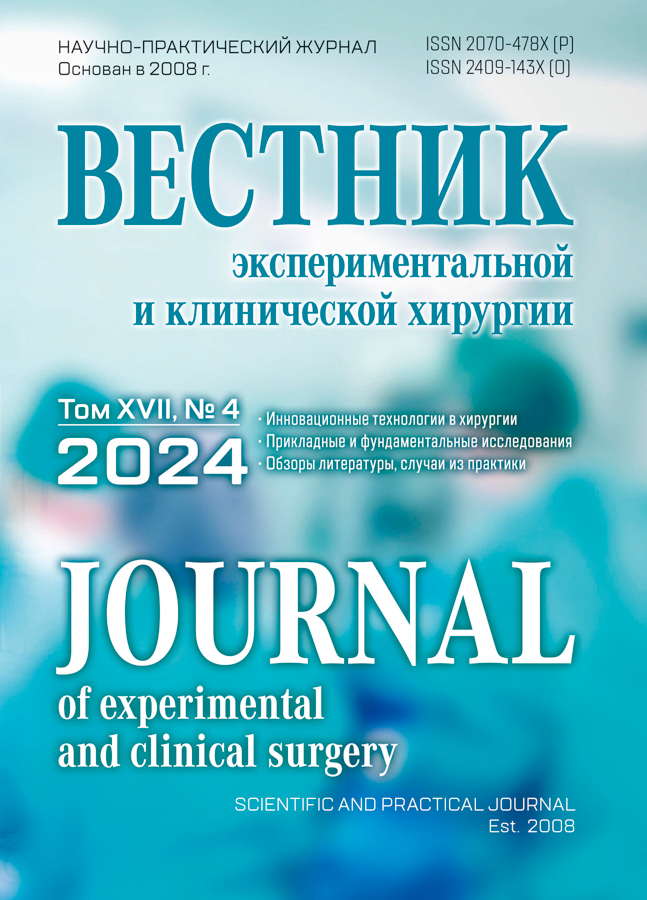Treatment of Posttraumatic Liver Abscess: a Case Study
- Authors: Tarasenko S.V.1, Tyulenev D.O.1, Kopeikin A.A.1
-
Affiliations:
- Ryazan State Medical University
- Issue: Vol 17, No 4 (2024)
- Pages: 192-197
- Section: Cases from practice
- URL: https://vestnik-surgery.com/journal/article/view/1746
- DOI: https://doi.org/10.18499/2070-478X-2024-17-4-192-197
- ID: 1746
Cite item
Abstract
Liver abscess is a severe, multifactorial disease that occupies from 1 to 3% of the pathology structure of the hepatobiliary system. In the absence of proper treatment, the disease is accompanied by high mortality. Despite all the achievements of modern medicine, the problem of treating liver abscesses remains as relevant as ever. Approaches and techniques of diagnosis and treatment are changing, but such patients still require a versatile approach to treatment. This paper presents a brief overview of the history, modern ideas about the etiology and pathogenesis of liver abscesses, highlights the main tactical approaches in treatment, and the associated features of the course of the disease. A brief overview and comparative analysis of the most common, available and modern treatment options of liver abscesses is given. As an example of successful treatment of liver abscess, a clinical case of minimally invasive ultrasound-guided management of a post-traumatic liver abscess is given, the option is widely used in our clinic. The main stages of treatment, the therapy performed and the invasive interventions performed are described. This treatment option clearly demonstrates the effectiveness of minimally invasive techniques in the treatment of liver abscesses. Thus, the article is a brief insight on the main aspects of the liver abscesses treatment, illustrated by a clinical example of successful treatment of post-traumatic liver abscess.
Full Text
About the authors
Sergey V. Tarasenko
Ryazan State Medical University
Author for correspondence.
Email: surgeonsergey@hotmail.com
ORCID iD: 0000-0002-1948-5453
SPIN-code: 7926-0049
M.D., Professor, Head of the Department of Hospital Surgery
Russian Federation, RyazanDaniil O. Tyulenev
Ryazan State Medical University
Email: dtyulenev@yandex.ru
ORCID iD: 0000-0001-5919-2180
Ph.D., Assistant of the Department of Hospital Surgery
Russian Federation, RyazanAlexander A. Kopeikin
Ryazan State Medical University
Email: akopeykin@yandex.ru
ORCID iD: 0000-0002-2198-1464
SPIN-code: 4011-8705
Ph.D., Associate Professor of the Department of Hospital Surgery
Russian Federation, RyazanReferences
- Lardiиre-Deguelte S, Ragot E, Amroun K. Hepatic abscess: Diagnosis and management. J Visceral Surgery. 2015; 152: 4: 231–243. doi: 10.1016/j.jviscsurg.2015.01.013
- Khatsko VV, Shatalov AD, Zubov AD. Modern possibilities of diagnosis and surgical treatment of bacterial liver abscesses. Bulletin of Emergency and Restorative Medicine. 2013; 14: 3: 369–372. (in Russ.)
- Zemskov VM, Kozlova MN, Shishkina NS. The use of immunotropic therapy in the treatment of a patient with a liver abscess (clinical observation). Russian Medical Journal. 2014; 22: 31: 2227–2229. (in Russ.)
- Zubov AD, Wilson DI. Posttraumatic liver abscesses: ultrasound diagnostics and minimally invasive echocontrol treatment. Trauma. 2014; 15: 3: 89–93. (in Russ.)
- Alperovich BI. Khirurgiya pecheni. M.: GEOTARMedia. 2010; 352. (in Russ.)
- Merzlikin NV. Rukovodstvo po khirurgii ochagovykh parazitarnykh zabolevanii pecheni. Tomsk: Pechatnaya manufaktura. 2014; 468 – EDN UBBTVR. (in Russ.)
- Stepanova YA, Goncharov AB, Zhao AV. Ultrasonic Diagnostics at the Stages of Liver Echinococcois Treatment. Journal of Experimental and Clinical Surgery. 2022;15(3):244-253. doi: 10.18499/2070-478X-2022-15-3-244-253 (in Russ.)
- Achkasov EE, Zapolsky AG, Alekperov SF, Yuri AV. Possibilities of minimally invasive methods of treatment of multiple liver abscesses. Surgical practice. 2011; 1: 5–7. (in Russ.)
- Unguryan VM, Svyatnenko AV, Surov DA. Surgical tactics for the treatment of cholangiogenic liver abscess in a patient with an aberrant cystobiliary duct (a case from practice). Medline.ru. 2014; 15: 2: 299–308. (in Russ.)
- Ustinov GG, Soloshchenko MF, Engovatova GM. Liver abscess: possibilities of instrumental diagnostics. Bulletin of the East Siberian Scientific Center of the Siberian Branch of the Russian Academy of Medical Sciences. 2011; 4: 107–108. (in Russ.)
- Saleem A, Clement LK, Sameer PJ. Percu-taneous drainage for giant pyogenic liver abscess – is it safe and sufficient? The American Journal of Surgery. 2016; 211: 1. 95–101. doi: 10.1016/j.amjsurg.2015.03.002
- Gavrilyuk VP, Lipatov VA, Lazarenko SV, Severinov DA. Assessment of the adhesion process after liver injury in chronic experience. Science of the young (Eruditio Juvenium). 2021; 9: 2: 212-225. doi: 10.23888/HMJ202192212-225. (in Russ.)
Supplementary files

















